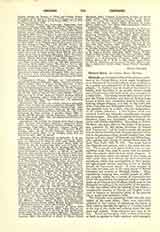

Chinooks, an aboriginal tribe of the extreme northwest of the United States, which might be adduced as an instance of the baneful effects of our civilization on a people not prepared for it by the influence of religion. Its habitat was the basin of the lower Columbia, from the Dalles to its mouth, except a small area of land on the south bank of the river occupied by a Deng tribe. The family was divided into the Lower and the Upper Chinooks, and they all lived in large houses of wood, each containing several families and forming villages situated, as a rule, on the north side of the Columbia and Willamette rivers. Each village was presided over by a chief, who was independent of all outside influence. A few of these head men attained wealth and enjoyed a consideration unusual among savages. The most prominent of them within historical times was Comcomly, who received the Lewis and Clarke expedition. According to Father De Smet, this man, when at the height of his power, was preceded by 300 slaves whenever he visited Fort Vancouver, “and he used to carpet the ground that he had to traverse, from the main entrance of the fort to the governor’s door, several hundred feet, with beaver and otter skins” (Chittenden and Richardson, Life, Letters, and Travels of Father Pierre Jean De Smet, New York, 1905, II, 443). The staple food of the Chinooks was salmon, with a few roots and berries. These people were great traders and, as most maritime races, they used to barter with the interior tribes the objects obtained from white skippers. It seems that even before the advent of the whites on their coast, they were famous for their commercial excursions, which they accomplished in their beautiful high-prowed canoes, reaching as far as Nootka Sound, on Vancouver Island. A stray member of the tribe has been met in the very center of British Columbia and another at Wrangel, Alaska. These expeditions, bringing into contact people of different tongues, called for a means of communication which was provided in the shape of a jargon originally made up of Chinook and Nootkan words more or less disfigured according to the nationality of the speaker. To this was added, after the coming of the whites, a considerable number of French and English terms, until it became an intertribal idiom of the greatest use to trader and missionary alike.
The Chinooks were somewhat taller than the generality of the coast tribes. They were universally addicted to the custom of deforming the heads of their infants, through the agency of a board secured to the top of the cradle and pressing down the forehead and occiput. Their character was none of the best. Proud and haughty, their notions of honesty, at least as applied to their relations with strangers, were at best rather hazy, and the readiness with which their females fell preys to unprincipled whites does not speak well of their consideration for chastity. Practically their first contact with the whites dates from the visit of Captains Lewis and Clarke in 1805. Their numbers were then estimated at no less than 16,000. Though their first intercourse with the strangers was of a peaceful nature, they lost no opportunity later on to pilfer from the Astorian traders who established themselves among them in 1812. In 1829, however, their arrogance was somewhat curbed by the visitation of an epidemic which carried off four-fifths of their entire population. Through the French Canadians in the employ of the Pacific Fur Company, they had heard of the Christian religion; and the Rev. F. N. Blanchet (later Archbishop of Oregon City) even tells us that “very old crucifixes were found among them” when first visited by the Catholic priests (Memoire presente la S. Congregation de la Propagande, p. 12). This was in 1838, when, accompanied by the Rev. M. Demers (later Bishop of the Diocese of Vancouver) he arrived in the valley of the lower Columbia. The Chinooks who, by this time, had acquired most of the vices of the whites, did not show any particular enthusiasm for the creed of the missionaries. On the other hand, the latter were too few, and they had to limit their ministrations to the French Canadians with their large half-breed families, and to such of the natives as were sufficiently well disposed. Occasionally, however, some Chinooks would come to see them at Fort Vancouver, more out of curiosity than through a desire for instruction. In 1839 Father Demers speaks of “their abominable lives”, and it was only the following year (1840) that he could visit them at their homes, which he reached on May 22, as a band of Methodist preachers were landing at Astoria. During a stay of three weeks’ duration, he instructed the adults and baptized the children, but they soon relapsed into indifference. In 1851 another special effort was made, with little success, to reclaim them from their degenerate condition.
Gradually vice and disease further thinned their ranks, and it actually came to pass that the Lower Chinooks became extinct, while what remained of the upper part of the family, being scattered abroad, was soon more or less mixed with the neighboring tribes and shared with them in the spiritual assistance proffered. Today, there are not more than 300 Chinooks extant, who are found mostly on the Warm Springs, Yakima, and Grande Ronde reservations in Oregon.
A. G. MORICE

